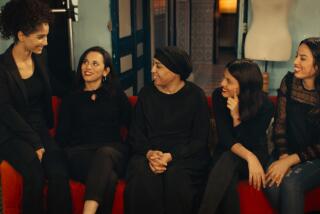DANCE REVIEW : Troupe Showcases Egyptian Traditions
- Share via
Toward the end of “Festival of the Nile,” a folk song from Upper Egypt reminds everyone that “God created much that is gold and much that is tin.” However, company director Abdel Rahman el Shafie obviously left the tin behind when assembling the distinguished 22-member ensemble that appeared at Ambassador Auditorium on Wednesday and moves to the Wadsworth Theater tonight.
From the black-robed male musicians who sway in unison with a monumental gravity on the sidelines to the female dancers who sensuously undulate center-stage swathed in the boldest plum and fuchsia (ornamented with cascades of gold or silver fringe), this is a company to treasure--guardians of performing traditions going back 30 centuries who are willing to adopt fabrics (and dyes) that no Pharaoh could ever have envisioned.
Officially the Nile Traditional Folklore Group of Cairo, the performers arrive in a fusillade of drums and a blare of archaic oboes. The musicians then sit under scroll-paintings of palm trees, pyramids, Nile sailboats and crescent moons, displaying their skills and encircling the dancers and singers who periodically appear.
The extended, alternating solos for wiry flute (Ibrahiem ali Ibrahiem) and whiny oboe (Mohammed Kamal) in “Our Country in the Moonlight” might perhaps be more appreciated outdoors, at a distance, but the coconut and horsehair fiddle known as the rabab makes a disarmingly delicate contribution to the evening. And, as sung by Adel Abdella Ahmed, Moussa Mohammed Mohammed and others, the lusty songs encourage rhythmic clapping from even those audience members not able to sing along.
The dance segments include Moufadel Mohammed Ahmed and Khalaffa Khalil Ahmed in a stylized stick fight (ancient in origin) that involves many of the same pole-swirling maneuvers as the women’s Ghawazee trio in the “Delta” segment. The women, however, glory in a rich vocabulary of hip and pelvic rotation while the men (poor devils) are traditionally forbidden that domain of expression and can only step to the beat or shimmer their fingers.
The evening teems with male-female contrasts of this sort. Mohamed Salama’s Nubian drum-dance exploits, complex footwork and masculine versatility (he sings, he dances, he drums) as opposed to the “Oriental Candelabra” solo in which you scarcely see any steps and Mahassen Helal Hassan shakes and rolls nearly every part of her anatomy while balancing a three-tiered, 10-pound metal candlestick-holder on her head. Pasadena fire regulations prevented any of the dozen candles from being actually lit on Wednesday, which lessened the impact of the solo but not its difficulty.
*
Elsewhere on the program, Haiem Farouk, Azza Hamada and other vibrant soloists provided more conventional showcases of what’s commonly labeled “belly-dancing,” though, of course, no bellies were ever bared, much less shoulders or legs. (Cairo definitely isn’t Istanbul.)
Despite all the feminine mastery on view, however, it was a male dancer who stopped the show. In “El Tannoura,” Moustafa Mohammed Garib made a 14th-Century dervish ritual into an amazing test of stamina and control--whirling in place under layers of kaleidoscopic robes and then raising them, one by one, to form color-wheels, pinwheels, spinning-tops and other sculptural configurations out of colored cloth, human energy and centrifugal force.
On a 14-part program otherwise organized for maximum variety, “El Tannoura” was allowed to accumulate overwhelming force over time, passing from athletic feat into metaphor and fusing the geometric purity of its imagery with the devotional fervor of its performance.
* “Festival of the Nile” repeats tonight at 8 in the Wadsworth Theater, Veterans Administration grounds, Brentwood. $9-$25. (310) 825-2101.
More to Read
The biggest entertainment stories
Get our big stories about Hollywood, film, television, music, arts, culture and more right in your inbox as soon as they publish.
You may occasionally receive promotional content from the Los Angeles Times.









